#emma beddington
Explore tagged Tumblr posts
Text

The Story: Fish doorbells! Historic sandwiches! 50 of the weirdest, most wonderful corners of the web
The Writer: Emma Beddington
0 notes
Text
#halloween#halloween history#history of halloween#halloween costumes#vintage halloween#the guardian#emma beddington#sarah gilbert
1 note
·
View note
Text
0 notes
Photo
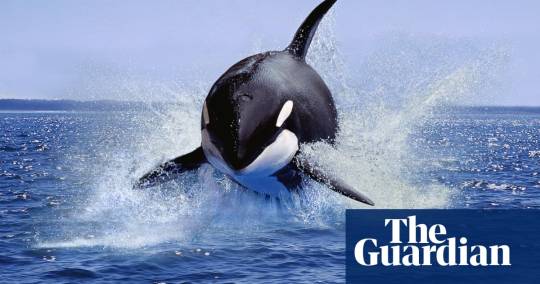
The orca uprising: whales are ramming boats – but are they inspired by revenge, grief or memory? A pod in the strait of Gibraltar has sunk three boats and damaged dozens of others, and their story has captivated the world. What explains this unprecedented behaviour?What’s going on with the #orcauprising? You’ve probably gathered the basics: orcas are “attacking” yachts. To be strictly factual, since 2020, a small pod of orcas in the strait of Gibraltar has been interacting with sailing boats in a new way: ramming vessels, pressing their bodies and heads into the hulls and biting, even snapping off, the rudders. Over three years, more than 500 interactions have been recorded, three boats sunk and dozens of others damaged. Last month, the first instance of this behaviour was recorded in another place, when an orca rammed a boat near Shetland. “What I felt [was] most frightening was the very loud breathing of the animal,” said the Dutch yachtsman targeted, Dr Wim Rutten, who had been fishing for mackerel. “Maybe he just wanted to play. Or look me in the eyes. Or to get rid of the fishing line.”There are two fascinating things about this. First, of course, what are the orcas doing? But the second is about another species entirely: us. Why do we like this story so much? Because we do: people – including me – love the idea of orcas attacking boats. Browsing through orca memes, there’s an orca as the sickle in the hammer and sickle, with the headline “eat the rich”, and a Soviet-style graphic of a heroic orca emerging under a superyacht. “What if we kissed while watching the orcas take back the ocean,” reads one tweet with 1m views, while a much-used image of an arm holding a microphone up to a captive orca has been repurposed endlessly to highly entertaining effect – I like one where it’s “singing” a bespoke version of the Meredith Brooks classic: “I’m a bitch / I’m an orca / Sinking yachts /Just off Majorca [sic] / I’m a sinner I’m a whale / Imma hit you with my tail.” We’re taking great pleasure in projecting extremely human narratives and motivations on orcas. But how wrong is that, and why does it appeal? Continue reading... https://www.theguardian.com/environment/2023/jul/11/the-orca-uprising-whales-are-ramming-boats-but-are-they-inspired-by-revenge-grief-or-memory
0 notes
Text
33 notes
·
View notes
Text
4 notes
·
View notes
Text
#science#science communication#scicomm#stem#science education#science blog#space#physics#extraterrestrial life#space travel#outer space#astronomy
2 notes
·
View notes
Text
This is actually a good article from Emma Bidbods... We stan
7 notes
·
View notes
Text
From ferret electricians to landmine-sniffing rats – meet the extraordinary animals that work for a living
Sometimes the right person for the job isn’t a person at all …
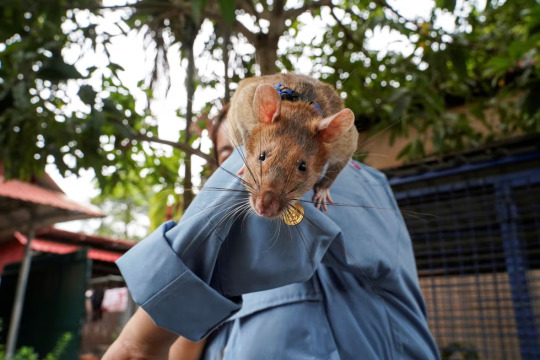
Magawa, a recently retired mine-detecting rat, plays with his former handler in Cambodia. Photograph: Cindy Liu/Reuters
by Emma Beddington
Thu 19 Oct 2023 11.00 CEST
Our relationship with animals is deeply peculiar, spanning the spectrum from besotted to breezily exploitative. Whether they are friends, pests, assets, dinner or catnip content creators, the relationship tends to be heavily skewed in our favour. We might look after our pets devotedly, but most animals aren’t so lucky in their encounters with us.
There are a few instances, however, where human interests and animals’ natural behaviours and inclinations more or less align. Most aren’t technically “mutualistic” interactions between two species that benefit both, like a clownfish hiding in and cleaning up its sea anemone. Even so, there is a cheering amount of win-win in a handful of our relationships with the natural world. Let’s take a look at some of that mutual back-scratching.
Bat librarians

Careful curators … bats have lived in the Joanina library at the University of Coimbra in Portugal for centuries. Photograph: Marcin Jamkowski/Adventure Pictures/Alamy
The baroque Joanina Library at the University of Coimbra in Portugal is well known for its exquisitely detailed gilding and woodwork, but also for what its deputy director, António Maia do Amaral, calls its “honorary librarians”: bats. Amaral explains that there are two small colonies – free-tailed bats and pipistrelles – living in Joanina. They have been there for centuries: 18th-century library paperwork documents an order of large leather sheets from Russia; these sheets, known as “moscovias”, are still unrolled at night to protect the huge embossed tropical wood tables from bat droppings.
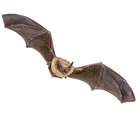
Literary wingman … a pipistrelle bat, one of two species found at Joanina. Photograph: Rudmer Zwerver/Alamy
Whether the bat librarians are actually helping is a moot point. The assumption is that they feed on book-eating insects that could damage the library’s precious collection, but their droppings have never been analysed to check. “As far as I know, it has always been a peaceful coexistence, even if their role in pest control is maybe marginal,” says Amaral. “We cannot trust bats alone to preserve the books from flying insects. For that purpose, we have a six-cubic-metre anoxic chamber for cleaning the books.”
The bats are part of the library anyway, even if they are only occasionally spotted (usually at evening events, when they flutter out from the shelves to entertain guests). Visitors are intrigued – you can even get a baseball cap with a Joanina bat on it – but opinions within the library vary. “My first director was always very annoyed when asked about the bats’ existence,” says Amaral. “He felt that bats were the least important thing in the library, because he was such a cultured man. Nowadays, people are more often benevolent and amused with the bat story. Personally, I’m very happy with the bats and pray for their good health.”
The bats weren’t the only honorary librarians in previous centuries, Amaral adds. Historical library records included an annual sum in the budget for feeding Joanina’s mouse-hunting cats; you can still spot “cat doors” cut into the woodwork.
Ferret electricians
youtube
The cutest cable guys … ferrets strut their stuff on Channel 4.
“Ferrets are, if you want to be polite, inquisitive; if you want to be blunt, they’re nosy little devils,” says James McKay of the National Ferret School. “When you put them in any opening, they want to go through and see what’s at the other end.” Their curiosity, shape and sinuous flexibility mean they can get to places and do jobs no human could manage. Felicia the ferret became a furry pipe cleaner for the Fermilab particle accelerator in Illinois in 1971; ferrets wriggled under the floor of St Paul’s Cathedral to enable TV transmission of the royal wedding in 1981 and cabled the Millennium Dome (the work of three called Beckham, Posh and Baby).

Naturally inquisitive … ferrets can squeeze into spaces that humans can’t. Photograph: Farlap/Alamy
How does the cabling work? The ferret wears a harness attached to a long, light nylon line. Once it has threaded the line through a duct, the line is attached to a heavier pull rope to thread the cable. Although there is some training involved – the school has a training area with a range of vertical and split pipes and cul-de-sacs – it is really a case of capitalising on the ferrets’ natural inclination to investigate holes. A bit of salmon oil at the far end of a long pipe as a reward can help them find their way. The furthest one of McKay’s ferrets has travelled is about 250 metres: “We’ve never had one get halfway and decide to come back.”
The school’s business (the delightful collective noun for ferrets) numbers about 50 and McKay usually takes half a dozen along on a job in case someone isn’t in the mood. The hobs (males, which are larger) can pull lines longer distances, while the smaller jills (females) are better at wriggling through the narrowest spaces. Does he have a favourite ferret? “They’re all as good as each other.”
Winemaking ducks and spiders

How winemaking ducks help Vergenoegd Löw vineyard – video
At the Vergenoegd Löw winery in South Africa, pest control on the vines is the responsibility of a flock of more than 1,000 Indian runner duck “soldiers”. They emerge in a cacophony of honks every morning and spend the day eating aphids, snails and worms, keeping the vines pest-free and healthy. They circulate in a 14-day loop around different areas of the vineyard, with their droppings providing a bonus fertiliser. The ducks take a break only during harvest – grapes are just too tempting – when they get a holiday to swim in a nearby lake, forage on farmland and, er, work on producing the next generation of vineyard soldiers.
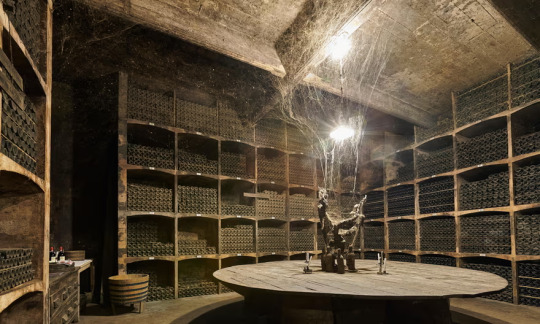
A corking idea … gigantic cobwebs drape the cellar walls at R López de Heredia winery in La Rioja, Spain. Photograph: Agefotostock/Alamy
Meanwhile, at the R López de Heredia winery in La Rioja, gigantic cobwebs drape the cellar walls and yet more cover the bottles. They aren’t Halloween props or atmospheric decor: they are home to the spiders who help the López de Heredia family keep their barrels and corks free from cork-eating moths – “the mortal enemy of long‑ageing wine”.
Diagnostic technician and demining rats
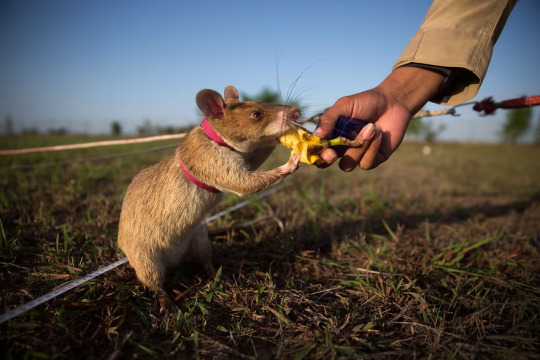
Another fruitful endeavour … one of Apopo’s rats gets a tasty treat for identifying an inactive mine in Cambodia. Photograph: Taylor Weidman/Getty Images
The 300 African giant pouched rats employed by the NGO Apopo are multitalented. Not only have they worked on mine clearance in south-east Asia and Africa, but they also sniff out positive tuberculosis sputum samples.
Why are they so good at the job? “They’ve very smart; they’re sociable; they have an excellent sense of smell,” says Lily Shallom of Apopo. “In the past, we’ve found that they can smell a picogram of TNT – a trillionth of a gram.” The rats are “very motivated by food. They like to stuff their cheeks; they have a sweet tooth and they love anything that’s got a really high fat and protein content.” Peanuts and bananas are particular favourites.
The rats signal when they have found a mine by scratching at the surface of the ground. (Weighing a maximum of 1.5kg, the rats are much too light to set off a mine; none have been hurt in the field.) A TB sample, meanwhile, is flagged as potentially positive if a rat hovers over it for three seconds.
youtube
Reporting for duty … Apopo’s life-saving rats.
It’s a nice life for these highly sociable creatures. Training (which takes nine months on average) or work make up a tiny portion of the rats’ day: mine detection sessions last about 20 minutes, building up to half an hour. Assessing 100 TB samples – the standard batch size – takes a maximum of 20 minutes, but could take a human technician up to four days. The rest of the rats’ day is devoted to free play, hanging out with other rats, snacking and napping.
Apopo is always exploring potential uses for the rats’ special skillset at its training and research centre in Tanzania. Projects include searching for survivors of natural disasters, detecting illegally trafficked pangolin scales and decontaminating land, with the rats deployed to detect specific concentrations of hydrocarbons in soil.
Honey-hunting birds
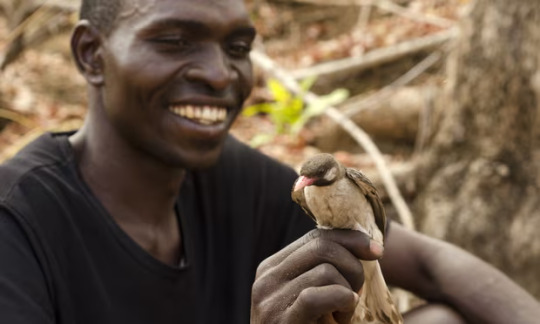
Birds of a feather … a honey hunter studies a greater honeyguide at the Niassa national reserve in Mozambique. Photograph: Claire Spottiswoode/AP
Humans and greater honeyguides have a genuinely mutualistic relationship: the small, brown‑ish African relative of the woodpecker flutters in front of people, tweeting to guide them to bees’ nests in hollow tree trunks. The humans then smoke out the potentially dangerous bees and take the honey. The honeyguide watches and waits until they have finished, then enjoys its preferred food: beeswax.
youtube
On song … how honeyguides talk to people.
In 2016, a research team at the University of Cambridge discovered that communication between honeyguides and humans goes both ways. They learned that honey hunters from the Yao community in Mozambique have a better chance of attracting honeyguides, and finding honey, if they use a specific sound: “A loud trill followed by a short grunt: brrr-hmm.” The call increased the overall chance of finding honey from 16% to 54% compared with control sounds. “The ‘brrr-hmm’ call more than tripled the chances of a successful interaction, yielding honey for the humans and wax for the bird,” reported Dr Claire Spottiswoode, who led the project.
Hawk bouncers

Top flight … a working hawk at the Hayward Gallery, London. Photograph: Stephen Chung/Alamy
Why do pigeons need to be deterred? According to Citihawk’s Leigh Holmes, they represent a twofold health hazard: “Pigeon fouling contains horrendous amounts of bacteria and parasites – and when wet it becomes very slippery,” she says. The hawks aren’t there to attack or eat the pigeons – that never happens, according to Holmes. They would rather fly back for chicken pieces held by their handlers. The aim is to scare them off and discourage them from returning. The theory, says Holmes, is that “pigeons see a natural predator that they are in-built to be fearful of … They disappear to find somewhere safer to roost, nest and feed.”
The hawks fly free, exploring wherever they like on the day’s site. “They love the exercise; they love getting out and flying,” says Holmes. She thinks they particularly relish working in urban areas. “They really enjoy some of the hustle and bustle, because they fly exceptionally well.” That freedom does mean they sometimes go awol. “They can be quite childlike at times and see a pigeon a street away or on another roof. They will literally just go to scare off other birds.” The hawks are fitted with trackers, so the handlers can follow their movements in real time.
Harris’s hawks are good at this work because they are naturally gregarious and used to hunting collaboratively in the wild, says Holmes. When trained by humans, they view their falconer as part of their hunting team. “They learn to read each other,” she says. “It’s incredible. It’s an amazing feeling for the staff members.”
Another big part of the falconer’s job is interacting with amazed and delighted members of the public: “The amount of photographs taken, the amount of interest and the amount of love for birds of prey … People just love it.”
4 notes
·
View notes
Text
We’re all insecure and hungry for validation, aren’t we?
Tired of hearing everyone talk, with false humility, about what they’ve accomplished over the past year? Me too
Be careful out there: it’s boasting season. Maybe you’ve already been cornered at a party, received your first round-robin email, opened a card to find a typed insert of “family news”, or stumbled on a social media post where someone lists their 2023 accomplishments with the baffling hashtag #humbled (you’re not, are you? Quite the opposite)...
I struggle with “success bombing” as I saw it described recently; everyone’s accomplishments all up in your face. Saying that makes me sound like I’m self-effacingly modest, a paragon of self-deprecation, which would be a brag of sorts, too – but I’m not modest. I’m insecure, in thrall to comparison, inclined to see others’ successes as a reproach for all I haven’t achieved. Isn’t there a bit of that in both extremes of this dance-off between compulsive self-deprecation and the desire to scream success from the rooftops? We’re all insecure and hungry for validation, aren’t we?
Well, not all of us. I’ve realised it’s possible not to feel threatened by other people’s expressions of pride at their and their family’s successes, whether or not it tips into bragging. I know, because there are people in my life who are comfortable and secure on their own path, able to feel simply happy for others, or if someone’s really overegging it, gently, indulgently amused. I wish I was like them, the weirdos.
So maybe those of us who feel a twinge of recognition at that Gore Vidal quote about dying inside at others’ success need to find a coping strategy other than grinding our teeth to dust? This year, I’ve adopted a blandly beatific: “That’s wonderful!” Because actually, I suppose it is? Anything that adds a drop to the leaky pot of human happiness is worth embracing.
— Emma Beddington, from "Boasting season is upon us – and it can’t end soon enough" (The Guardian, December 18, 2023)
5 notes
·
View notes
Text

The Story: Sort out your life! 100 tiny tricks to help with everything from digital overwhelm to lumpy sugar and unpaid bills
The Writer: Emma Beddington
(illustration: Spencer Wilson at Synergy/The Guardian)
0 notes
Link
ASMR videos can mimic the feeling of physical touch, which a study has found is popular with young consumers. But how many intimate gestures of love, care and connection are they missing out on? You wouldn’t think a deep dive on slime-squishing and #BioTech #science
0 notes
Text
Good news, everyone!
— We appear to have reached peak longevity Forget blue zones, superfoods and hi-tech rejuvenation therapies: study after study suggests our dreams of immortality will never come true. But maybe that’s just the kick in the pants humanity needs By Emma Beddington The news hasn’t been good for people planning to live for ever. First came Dr Saul Newman’s investigative work into supercententarians –…

View On WordPress
0 notes
Text
The kids are eating us out of house and home – and I couldn’t be happier | Emma Beddington
http://dlvr.it/TCjhrs
0 notes